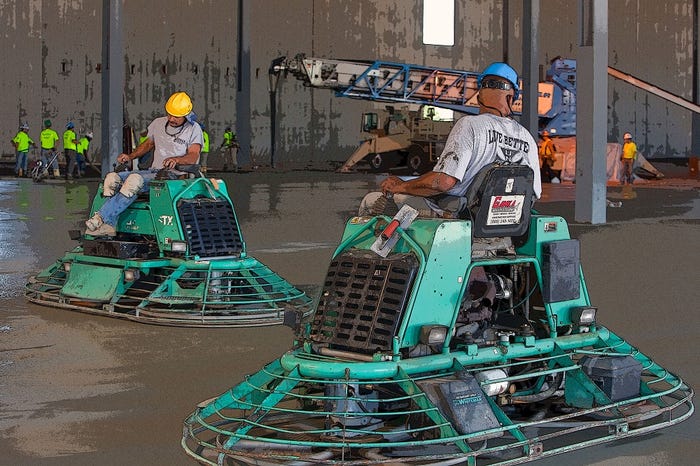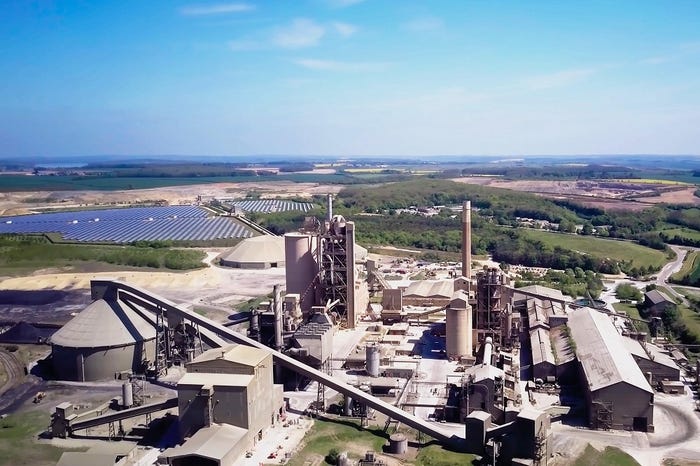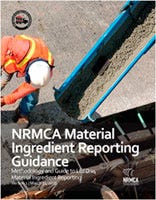As the RMC Research & Education Foundation celebrates its 30th anniversary, we look at its contributions in four industry aspects: concrete applications; recruitment, education & training; sustainability; and health & safety. In Part Three, we explore what the Foundation is doing to promote sustainable and resilient concrete and construction practices.
December 6, 2021

In 2019, The Guardian, a well-known media outlet, described concrete as “the most destructive material on earth,” despite their acknowledgement that concrete creates efficient and resilient structures that have advanced civilization for at least the past 100 years. Overcoing this negative image of concrete is something our industry must work very hard to overcome. While it’s true that the manufacture of Portland cement releases a significant amount of carbon dioxide, the cement and concrete industry has made great strides to improve its sustainability and the RMC Foundation has been instrumental in both supporting those programs and promoting the facts about concrete. Here are a few of the Foundation’s achievements towards that end.
Concrete Sustainability Hub
One of the most effective and credible efforts the concrete industry has made to demonstrate concrete’s environmental stewardship is establishment of the Concrete Sustainability Hub (CSHub) at the Massachusetts Institute of Technology (MIT), sponsored by the RMC Research & Education Foundation and the Portland Cement Association (PCA). The CSHub is a dedicated interdisciplinary team of researchers from several departments at MIT working on concrete and infrastructure science, engineering, and economics since 2009. The MIT CSHub brings together leaders from academia, industry, and government to develop breakthroughs using a holistic approach to result in durable and sustainable homes, buildings, and infrastructure in ever more demanding environments.

For buildings, the CSHub’s research has focused on durability, energy efficiency, and resiliency. Life-cycle analysis research at the CSHub has looked at the many factors that must be considered before evaluating claims that one or another building type or product offers a better environmental return. To understand the full environmental impact of a structure over decades of use, all phases, starting before construction and continuing through demolition, must be considered. Life cycle assessment (LCA) seeks to quantify the environmental impacts over the infrastructure life cycle by identifying the costs during each phase. The CSHub’s research has not only quantified concrete’s contribution but has shown how combining tools such as the CSHub-developed Building Attribute to Impact Algorithm (BAIA) with optimization methods can identify the best ranges for key design parameters. Since the use phase of a building accounts for up to 98% of the global warming potential, and with concrete’s thermal advantages, the impact of a concrete building is 5% to 8% lower than comparable structures.
For pavements, the CSHub’s research has focused on improving structure and design to increase fuel efficiency, lower maintenance costs, and improve life-cycle planning. For example, research has shown that concrete pavement, with its ability to reflect sunlight, reduces the heat-island effect in cities, reducing cooling costs and energy consumption in the summer. Life-cycle cost analysis also favors rigid concrete pavements over more-flexible asphalt. The research has shown that “two-thirds of a pavement’s total environmental impact over its lifetime occur during the phase in which the pavement is in use—well after material and design selections are made. CSHub research has found that optimizing pavement with expected use and pavement performance conditions in mind can improve costs and reduce CO2 emissions.”
The embodied carbon of Portland cement (the amount generated during its manufacture) is always raised as evidence of concrete’s negative impact on the environment, especially since it is the world’s most-used building material. America’s cement manufacturers, through PCA’s Roadmap to Carbon Neutrality, have committed to reaching carbon neutrality throughout the cement-concrete-construction value chain by 2050. Research conducted by the CSHub will make an important contribution towards reaching this goal.

Cement is a critical ingredient of concrete and the CSHub has looked at a variety of ways to lower the embodied carbon of cement and concrete, including the possibility of achieving carbon-neutral—or even carbon-negative—concrete. The CSHub’s former executive director Jeremy Gregory, however, sees concrete’s scale as an opportunity to mitigate climate change. “Concrete is the most-used building material in the world. And because we use so much of it, any reductions we make in its footprint will have a big impact on global emissions.” Carbon capture and the use of carbon directly in the concrete mix, according to the Center for Climate and Energy Solutions, will have a $400 billion global market by 2030.
Other teams at the CSHub have delved into the very basics of what concrete is. They have used a range of modeling techniques, starting at the atomic level, to develop structures and properties that improve how cement is designed, reduce CO2 emissions, and enable U.S. leadership in future cement technologies. For example, MIT scientists have demonstrated a way to watch the cement hydration reaction under real-world conditions, an advance that may help researchers find ways to make concrete more sustainable. “The study is a ‘Brothers Lumière’ moment for concrete science,” says Franz-Josef Ulm, professor of civil and environmental engineering and faculty director of the CSHub, referring to the two brothers who ushered in the era of projected films. “The MIT team has provided a glimpse of early-stage cement hydration that is like cinema in Technicolor compared to the black and white photos of earlier research.”
The CSHub has recently entered the third five-year funding cycle. In its 2019 annual report, it noted that researchers have persisted in innovating novel solutions to old problems in the fields of resilience, infrastructure, and sustainability. Their efforts led them to give 31 presentations—two of which were before members of Congress. In total, they published nine journal articles, including one in the Proceedings of the National Academy of Sciences. CSHub researchers also contributed to broader conversations of sustainability and resilience in national media outlets like The New York Times, The Wall Street Journal, and USA Today.
Pervious Concrete
Reducing runoff from concrete pavements prevents pollutants that collect on the surface from draining into rivers and streams. Properly designed and constructed, pervious concrete pavements also reduce or eliminate a surge into combined sewers from stormwater following a storm. And pervious pavement is safer since it dries more quickly than conventional concrete surfaces. But pervious pavements are not foolproof and require knowledgeable design and construction practices.
The RMCREF has invested into pervious concrete research and resources so that all these advantages can be achieved with successful installations in any climate including extreme freeze-thaw regions. The Foundation funded the development of the Craftsman Text for NRMCA’s Pervious Concrete Contractor Certification. This book serves as the primary training tool to support a comprehensive certification for those who place pervious concrete.
Other pervious concrete pavement resources funded by the Foundation include:
An Integrated Study of Pervious Concrete Mixture Design for Wearing Course Applications provides widely accessible and easily applied guidance for designers, producers, contractors, and owners. It begins with pervious concrete best practices and then provides examples of successful projects.
Performance Evaluation of In-Service Pervious Concrete Pavements in Cold Weather looks at the structural and hydraulic performance as well as durability.
Pervious Pavement Field Performance Investigation on Parking Lot and Roadway Pavements demonstrates the successful use of pervious concrete in freeze-thaw environments, with little maintenance required.
Compressive Strength of Pervious Concrete Pavements examines the relationship between strength and permeability.
Construction & Maintenance Assessment of Pervious Concrete Pavements details construction and maintenance issues to ensure maximum performance of pervious concrete.
Hydraulic Performance Assessment of Pervious Concrete Pavements for Stormwater Management Credit focuses on the stormwater management properties of pervious concrete and how it can be considered a best-management practice for EPA requirements.

Other Sustainability-Related Resources
The Foundation has funded a wide variety of sustainability research. Here’s a sample:
NRMCA Materials Ingredient Reporting Guidance provides guidance into how ready mixed concrete producers can contribute to LEED credits
Sustainable Concrete Plant Guidelines provides the basics for the Sustainable Concrete Plant Certification offered by the National Ready Mixed Concrete Association.
Crushed Concrete Aggregate as Aggregates for New Concrete details how the proper use of crushed returned concrete can save the concrete industry $300 million annually in materials and disposal costs.
New Technology-Based Approach to Advance Higher Volume Fly Ash Concrete with Acceptable Performance – Guide for the Construction Team provides recommendations on the application of the maturity method to support the use of optimized HVFA concrete mixtures by providing a simple method to estimate in-place strength development.
Effect of Pavement Type on Fuel Consumption and Emissions in City Driving is a research report that includes a companion tool, the Roadway Fuel Consumption and Emissions Calculator. To get this tool, contact Jennifer LeFevre.
All of this is only a small sample of the tools developed over the past 30 years by the RMC Education & Research Foundation for concrete applications. Today, the Foundation administers a $27 million endowment that seeds innovation across the industry. Contributions to the RMC Research & Education Foundation support research and educational programs to improve and advance the concrete industry. As a 501 (c) 3 non-profit organization, contributions to the Foundation are fully tax deductible. To learn more about how to become a supporter, click here.
Read more about:
sustainabilityYou May Also Like


